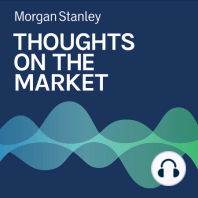3 min listen
Looking Back for the Future
ratings:
Length:
5 minutes
Released:
Apr 8, 2024
Format:
Podcast episode
Description
Our Global Chief Economist explains why the rapid hikes, pause and pivot of the current interest rate cycle are reminiscent of the 1990s.----- Transcript -----Welcome to Thoughts on the Market. I'm Seth Carpenter, Morgan Stanley's Global Chief Economist. Along with my colleagues bringing you a variety of perspectives, today I'll be talking about the current interest rate cycle and the parallels we can draw from the 1990s.It's Monday, April 8th, at 10am in New York.Last year, we reiterated the view that the 1990s remain a useful cycle to consider for understanding the current cycle. Our European equity strategy colleagues shared our view, and they've used that episode to inform their ‘out of consensus, bullish initiation on European equities’ in January. No two cycles are identical, but as we move closer to a Fed cut, we reassess the key aspects of that comparison.We had previously argued that the current interest rate cycle and the mid 90s cycle differ from the intervening cycles because the goal now is to bring inflation down, rather than preventing it from rising. Of course, inflation was already falling when the 1994 cycle started, in part, because of the recession in 1991.This cycle -- because much of the inflation was driven by COVID-related shocks, like supply chains for consumer goods and shifts in housing for shelter inflation -- inflation started falling rapidly from its peak before the first hike could have possibly had any effect. In recent months, our economic growth forecasts have been regularly revised upward, even as we have largely hit our expected path for inflation.A labor supply shock appears to be a contributing factor that accounts for some of that forecast deviation, although fiscal policy likely contributed to the real side's strength as well. Supply shocks to the labor market are an interesting point of comparison for the two cycles. In the 1990s, labor force growth was still benefiting from this multi-decade rise in labor force participation among females. The aggregate labor force participation rate did not reach its peak until 2000.Now, as we've noted in several publications, the surge in immigration is providing a similar supply side boost, at least for a couple of years. But the key lesson for me for the policy cycle is that monetary policy is not on a pre-set, predetermined course merely rising, peaking and then falling. Cycles can be nuanced. In 1994, the Fed hiked the funds rate to 6 per cent, paused at that peak and then cut 75 basis points over 1995 and 1996. After that, the next policy move was actually a hike, not a cut.Currently, we think the Fed starts cutting rates in June; and for now, we expect that cutting to continue into next year. But as our US team has noted, the supply side revisions mean that the path for policy next year is just highly uncertain and subject to review. From 1994 to 1996, job gains trended down, much like they have over the past two years.That slowing was reflective of a broader slowing in the economy that prompted the Fed to stop hiking and partially reverse course. So, should we expect the same now, only a very partial reversal? Well, it's too soon to tell, and as we've argued, the faster labor supply growth expands both aggregate demand and aggregate supply -- so a somewhat tighter policy stance could be appropriate.In 1996, inflation stopped falling, and subsequently rose into 1997, and it was that development that supported the Fed's decision to maintain their somewhat restrictive policy. But we can't forget, afterward, inflation resumed its downward trajectory, with core PCE inflation eventually falling below 1.5 per cent, suggesting that that need to stop cutting and resume hiking, well, probably needs to be re-examined.So, no two cycles match, and the comparison may break down. To date, the rapid hikes, pause and pivot, along with a seeming soft landing, keeps that comparison alive. The labor supply shock parallel is notable, but it also points to what mig
Released:
Apr 8, 2024
Format:
Podcast episode
Titles in the series (100)
Andrew Sheets: For Markets, Signs, Signs, Everywhere Signs by Thoughts on the Market
